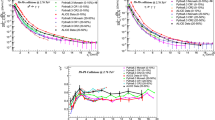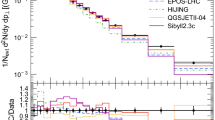Abstract
The \(\phi \) vector meson, lightest bound state of strange and anti-strange quarks, is considered as a good probe for the study of QCD matter formed in heavy-ion collisions. We have reported the transverse momentum (\(p_T\)) and rapidity (y) distributions of \(\phi \) mesons in pp collisions at SPS, LHC and RHIC energies in the kinematic interval of \(0< p_T < 1.5 \;GeV/c\) over a wide rapidity region. The results of Monte Carlo Simulations using PYTHIA8 event generator are compared to NA61/SHINE, ALICE and STAR experimental data. The PYTHIA8 model is used with default tune CR0 as well as with color reconnection tune CR1. The PYTHIA8 default tune (CR0) is MPI based while CR1 tune is QCD based. CR0 provides a good description of the ALICE data, while CR1 tune explains the ALICE data better than CR0. Some deviations are observed in \(p_T\) spectra. The observed deviations in the distributions are due to the kinematics involved in the model. In case of CR0, the deviations are due to the multiparton interactions and for CR1 tune, the non-perturbative QCD effects are more dominant which are due to parton fragmentation as discussed in Lund string model used in PYTHIA8. CR0 tune of PYTHIA describes ALICE data very well but cannot explain the STAR experimental data. The ratio of Monte Carlo to experiment data shows that the deviations are within the statistical uncertainty values.






Similar content being viewed by others
Data availability statement
This manuscript has associated data in data repository. [Authors’ comment: All data included in this manuscript are available upon request by contacting with corresponding author.]
References
F. Karsch, Lattice results on QCD thermodynamics. Nucl. Phys. A 698(1–4), 199–208 (2002)
R.V. Gavai, S. Gupta, On the critical end point of QCD. Phys. Rev. D 71(11), 114014 (2005)
K.G. Wilson, Confinement of quarks. Phys. Rev. D 10, 2445 (1974)
ALICE Collaboration, Transverse momentum spectra and nuclear modification factors of charged particles in Xe-Xe collisions at \(\sqrt{s_{NN}}\) = 5.44 TeV, Physics Letters B, Volume 788, 2019,Pages 166-179,ISSN 0370-2693
B. Muller, J. Schukraft, B. Wyslouch, First results from Pb + Pb collisions at the LHC. Annu. Rev. Nucl. Part. Sci. 62, 361–386 (2012)
U. Heinz, R. Snellings, Collective flow and viscosity in relativistic heavy-ion collisions Annu. Rev. Nucl. Part. Sci. 63, 123–151 (2013)
J.E. Bernhard, J.S. Moreland, S.A. Bass, J. Liu, U. Heinz, Applying Bayesian parameter estimation to relativistic heavy-ion collisions: simultaneous characterization of the initial state and quark-gluon plasma medium. Phys. Rev. C 94(2), 024907 (2016)
A. Ortiz, P. Christiansen, E. Cuautle, I. Maldonado, G. Paic, Color reconnection and flow-like patterns in pp collisions. Phys. Rev. Lett. 111(4), 042001 (2013)
C.M.S. Collaboration, V. Khachatryan et al., Long-range two-particle correlations of strange hadrons with charged particles in p-Pb and Pb-Pb collisions at LHC energies. Phys. Lett. B 742, 200–224 (2015)
Md. Nasim, Vipul Bairathi, Mukesh Kumar Sharma, Bedangadas Mohanty, Anju Bhasin, A Review on \(\phi \) Meson Production in Heavy-Ion Collision, Hindawi Publishing Corporation. Adv. High Energy Phys. 197930, 16 (2015)
Mikhail V. Malaev, Victor G. Riabov, Yuri G. Riabov, Yaroslav A. Berdnikov, Vladimir M. Samsonov, Determination of phi meson nuclear modification factors in the proton-lead nucleus interactions in the ALICE experiment at the LHC, St. Petersburg Polytech. Univ. J.: Phys. Math. 1(2), 174–177 (2015)
NA61/SHINE Collaboration, Measurement of \(\phi \) meson production in pp interactions at 40, 80 and 158 GeV/c with the NA61/SHINE spectrometer at the CERN SPS, Eur. Phys. J. C 80, 199 (2020)
P. Skands, S. Carrazza, J. Rojo, Tuning PYTHIA 8.1: the Monash 2013 tune. Eur. Phys. J. C 74, 3024 (2014)
Jesper R. Christiansen, Peter Z. Skands, String formation beyond leading colour. JHEP 08, 003 (2015)
Torbjörn Sjöstrand, Stefan Ask, Jesper R. Christiansen, Richard Corke, Nishita Desai, Philip Ilten, Stephen Mrenna, Stefan Prestel, Christine O. Rasmussen, Peter Z. Skands, An Introduction to PYTHIA 8.2, arXiv:1410.3012 (2014)
B. Andersson, G. Gustafson, G. Ingelman, T. Sjöstrand, Parton fragmentation and string dynamics. Phys. Rep. 97(2), 31–145 (1983)
Acknowledgements
We would like to acknowledge the COMSATS University (Islamabad Campus), Pakistan, and Shandong University (Qingdao campus), China, which provided us all the computing tools and suitable platform to perform the simulations and analysis.
Author information
Authors and Affiliations
Corresponding author
Rights and permissions
About this article
Cite this article
Tabassam, U., Ali, M., Siddique, I. et al. The production of \(\phi \) mesons at SPS, RHIC and LHC energies. Eur. Phys. J. Plus 137, 255 (2022). https://doi.org/10.1140/epjp/s13360-022-02489-x
Received:
Accepted:
Published:
DOI: https://doi.org/10.1140/epjp/s13360-022-02489-x




